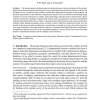Free Online Productivity Tools
i2Speak
i2Symbol
i2OCR
iTex2Img
iWeb2Print
iWeb2Shot
i2Type
iPdf2Split
iPdf2Merge
i2Bopomofo
i2Arabic
i2Style
i2Image
i2PDF
iLatex2Rtf
Sci2ools
ALGORITHMICA
1999
1999
Computational Approaches to Drug Design
Abstract. The rational approach to pharmaceutical drug design begins with an investigation of the relationship between chemical structure and biological activity. Information gained from this analysis is used to aid the design of new, or improved, drugs. Primary considerations during this investigation are the geometric and chemical characteristics of the molecules. Computational chemists who are involved in rational drug design routinely use an array of programs to compute, among other things, molecular surfaces and molecular volume, models of receptor sites, dockings of ligands inside protein cavities, and geometric invariants among different molecules that exhibit similar activity. There is a pressing need for efficient and accurate solutions to the above problems. Often, limiting assumptions need to be made, in order to make the calculations tractable. Also, the amount of data processed when searching for a potential drug is currently very large and is only expected to grow larger ...
| Added | 22 Dec 2010 |
| Updated | 22 Dec 2010 |
| Type | Journal |
| Year | 1999 |
| Where | ALGORITHMICA |
| Authors | Paul W. Finn, Lydia E. Kavraki |
Comments (0)

